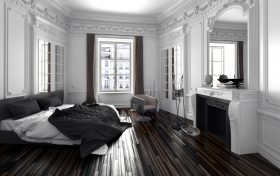Benefits and Different Types of Architectural Cornices and Moldings
Guest Post
One of the things that has always caught my husband’s eye whenever we were in the market to purchase a home, was the architectural details. Well, good design is in the details right? This post breaks down the types and benefits of architectural details and how they can make your home sing.
Adding architectural cornices & moldings to a structure is much like adding frames to a picture giving it a much more finished look. Whether the characteristics of your home are modern or conventional, cornices and moldings add an ornamental and beautiful element to and eases the transition from the wall or floor. Plain molds are known as covings. These are normally used for enhancing the looks, bridging between barriers, and in ceilings where cracks often appear. Although cornices are similar to moldings, they tend to be more decorative. In addition, moldings usually have uniform dimensions whereas cornices have varying projections and drop dimensions. Now, let us see different choices available for cornices and moldings.
image credit: shutterstock
Types of Cornices and Moldings
Moldings:
- Baseboards: These types of moldings are long strips of wood attached to the wall base that touch the floor. They build smooth transitions between the wall and floor. Baseboards are simple in shape and have an additional piece that enhances the aesthetics.
- Wainscoting: As we all know; architectural cornices & moldings add a decorative element and enhance the look of any building. Wainscoting is a type of paneling usually situated between baseboards and picture railings.
- Chair rail: These rails are installed usually alongside wainscoting. Chair rails usually lie midway on a wall.
- Picture rail: This type of molding is used to display art. This molding can help prevent destruction to the wall and creates an extra layer of decoration. In addition, it is a simple way to make sure that all of your art and pictures are hung at a uniform level.
- Casing: Architectural cornices & moldings have different styles and can be painted with different colors. However, casings are often the same color as the trim. They typically surround doors and windows.
- Crown molding: As the name implies, this type of molding is located at the seam between the ceiling and wall and looks like a crown. You can decorate your space by choosing the perfect design from many different styles of crown moldings.
Cornices:
image credit: shutterstock
Architectural cornices & moldings are available in different materials and sizes. Here are different materials used for cornices.
- Plaster: Plaster cornices are heavy and expensive. Usually, left unpainted so one needs to take proper measures to prevent it from getting dirty. It can be painted with water or oil based paint when being erected.
- Paper covered plaster: This type of cornice needs to be painted with water or oil based paint. These are fairly robust and medium weight.
- Polyurethane: It is readily available in different colors and patterns. Polyurethane cornices are robust and light in weight.
- Expanded polystyrene: Light weighted expanded polystyrene cornices are easy to damage. Cheaper versions have a bubble surface finish, which can be painted with emulsion.
- Timber: Timber cornices are light and flexible. They can be painted or varnished and can be cut to different shapes.
Reasons to Choose Decorative Cornices and Moldings
Here Are Five Top Reasons Why You Should Choose Architectural Cornices & Moldings:
- Conventional and modern look: Whatever you are aiming for whether traditional or modern style, ornamental cornices and moldings is an effective way for enhancing interior design.
- Add aesthetic factor: Cornices and moldings are perfect for adding a decorative element to the tops of walls, giving them an attractive and stylish look.
- Easy to install: The process of installing covings is simple. You can order readily cut moldings and mount them at the desired position.
- Add value to your property: Installing architectural cornices & moldings is a great way for converting a bare room into a visually interesting space. This will automatically add value to your property.
- Follow classiest interiors: Last but not the least, if you want to follow the world’s classiest interiors, installing cornices and moldings is the perfect way to achieve it.
If you are planning a remodel or building a new home, what architectural details would you consider?
Justin Jersey is a journalist, stylist and blogger. He is a aesthetician by heart who often writes about Art, Fashion, decorating and DIY ideas. He loves sparking creativity and giving them ideas for their own spaces.
Thanks for stopping by friends. We partner with busy homeowners to create spaces that feel authentic to their lifestyle and we blog about subjects that educate and inspire.
Contact us to learn more about our products and services. You can email us at rjackson@yourdesignpartner.com or call 513-409-3759
Inspiring creativity,
Ricci

Decorating or Refreshing Your Home?
Download our COMPLIMENTARY checklist and get access to our 7 Step Process to Decorate in Stages, Stay on Budget & Reduce Overwhelm.
Thank you for requesting our checklist head over to your email to get instructions on how to access it now!
We hate spam as much as you do we promise not to share any of your information...





